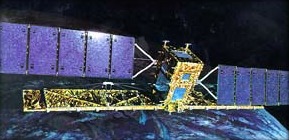

- Done using an internal gyroscope and small thruster jets or rockets
- Because its spin is so stable, the internal gyroscope can be used as a sensor to tell the satellite when its attitude (direction) is changing
- The satellite can then correct the problem using thrusters
- Thrusters usually contain compressed gas that when sent out of the end of the thruster will move the satellite in space
- The force of the compressed gas (the action) causes the satellite to move in the opposite direction (the reaction)
- This is Newton's third law of physics - for every action there is an equal and opposite reaction
- Thrusters, however, are heavy and use up lots of power
- The advantage is that the satellite as a whole can point stably in one direction; for example, the solar panels can always point at the sun, and the instruments can always point at their target
Home | Types & Uses | Anatomy of a Satellite | Canadian Satellite Q&A
You Be the Engineer | Image Gallery | Glossary | Credits
Produced by Galactics.
Comments: galactics@spacesim.org.
Last updated on: 8 August 1997.
![]()